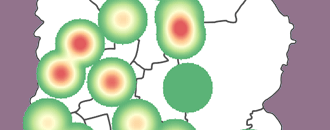
GeoHealth Mapping GIS Training
for Monitoring and Evaluation or
Strategic Information Officers and Data Analysts for HIV
So far we have demonstrated different methods of carrying out GIS analysis. Selecting the most appropriate method is very important. Some methods are quicker and give you approximate results, while others may require more detailed data and processing time. Your choice of method depends primarily on the question you would like answered, the availability of data, and how you decide to display your results. Note that in some instances a variety of methods may be required.
When determining an appropriate approach to analysis, consider the following:
- Frame your question of interest. In other words, what do you want to know about your data?
- Gather available data to answer your question.
- Are existing data available to answer the question?
- Can you triangulate multiple data sources?
- Do you need to collect data?
- Do you need to digitize data?
- Determine whether the question can be answered using a geographical approach.
- Would a chart, graph, or table be a better format to communicate your findings?
- Are you interested in displaying values or do you need a map to reveal patterns or relationships in the data?
- Select a method (or combination of methods) to help answer your question of interest.
The following case studies provide some examples of methods that are used to answer some common questions seen in HIV programming.
